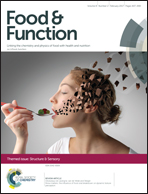The influence of lipid droplet size on the oral bioavailability of vitamin D2 encapsulated in emulsions: an in vitro and in vivo study
Abstract
Vitamin D deficiency is prevalent in some populations leading to adverse health effects, and therefore there is a need to supplement functional foods and beverages with this important micronutrient. In this study, we examined the influence of the initial lipid droplet size on the in vitro bioaccessibility and in vivo absorption of vitamin D2 encapsulated in oil-in-water emulsions. Changes in particle size, charge, and microstructure were measured as vitamin-loaded lipid droplets were passed through a simulated GIT (mouth, stomach, small intestine). The in vitro studies showed that smaller lipid droplets were digested more rapidly than larger ones, thereby leading to the more rapid formation of mixed micelles in the small intestine capable of solubilizing the lipophilic vitamins. This effect may account for the highest vitamin D2 bioaccessibility being observed for the emulsions containing the smallest droplets. In contrast, the in vivo rat feeding studies suggested that the absorption of vitamin D2 was the highest for the emulsions containing the largest droplets. The poor in vitro–in vivo correlation observed in our study may have occurred for a number of reasons: the simulated GIT did not accurately model the complexity of a real GIT; the in vivo approach used did not monitor changes in vitamin levels in the blood over time. Overall, this study suggests that particle size does influence the gastrointestinal fate of encapsulated oil-soluble vitamins, but that further work is needed to establish strong correlations between in vitro and in vivo methods.



 Please wait while we load your content...
Please wait while we load your content...